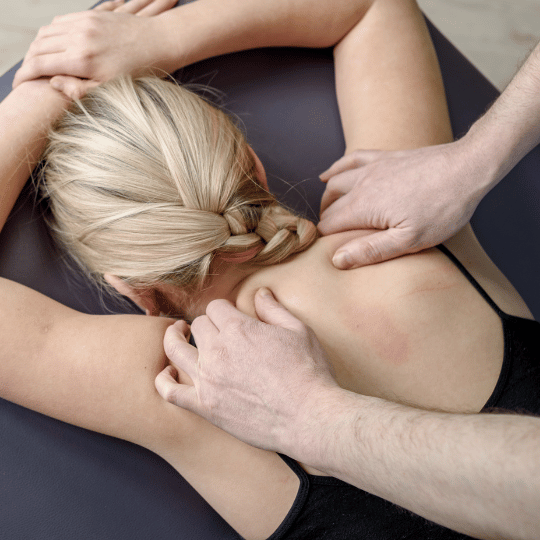More and more health specialists are talking about and treating this mysterious tissue, Fascia.
Lately, there has been an influx of patients in the clinic who tell us, “My massage therapist/chiropractor/acupuncturist told me that I have really tight fascia.” More and more health specialists are talking about and treating this mysterious tissue. Back in physical therapy school when dissecting cadavers, fascia was just cut through to be able to visualize and dissect the muscle. To turn back time and dissect out the fascia would have been most beneficial, because understanding the anatomy and physiology of fascia can help to explain how it can be perpetuating or even causing pain.
So what is this mysterious tissue called fascia?
Fascia is a connective tissue that is comprised mostly of collagen. There are three layers of fascia: the deep fascia and epimysial layer, the deep fascia and retinacula, and the superficial fascia. The superficial fascia adheres to the deep fascia and is connected with the skin. The deep fascia looks like a “second skin” underneath the superficial fascia. Deep fascia is named for the segment it surrounds. For example the brachial fascia surrounds the upper arm. Deep fascia is continuous with ligaments, tendons and epimysium. In part it is free to glide over muscles, and in part it is firmly anchored to the bone.
The inner surface of the deep fascia provides insertions for muscle fibers. Myofascial expansions permit selective tensioning and stretching of the fascia during movement which help stabilize the tendon and take the stress off the tendon attachment.1,2 Myofascial expansions allow communication between muscle, fascia and joints. When performing a certain movement, specific muscles ( or portions of muscle) contract and selective portions of the fascia are stretched. Fascia can then perceive a stretch produced by a muscle and transmit this tension to the joints over a distance.2
Fascia can be a source of pain because it is well innervated. Fascia has free nerve endings and pressure receptors that sit within it.2,3,4,5 This allows us to feel pain, and tell where our body is in space. According to Antonio Stecco, MD, PhD, “Fascia is the organ of proprioception, which means that this previously unknown ‘organ’ that encapsulates our entire being plays a lead role in knowing where your body is in space.”1
Another important component to fascia is hyaluronic acid. Hyaluronic acid is the WD-40 of our tissues. It lives within the extracellular matrix between deep fascia and muscle. It is a lubricant that allows smooth gliding between adjacent structures. This allows the tissue to absorb load and allow motion.6
So what happens when there is not normal slide or glide between the layers? What happens when a scar forms and fuses the superficial fascia to the deep fascia? When these two layers are connected, stretching the deep fascia could affect the superficial fascia and vice versa. This can result in overstimulation of free nerve endings and joint proprioceptors thus causing pain and poor movement patterns.7 When the layers of fascia become dense there is less blood flow, poor adaptation to stretch, less muscle activation all leading to abnormal tension and pain. Overtime your body begins to compensate to these changes which leads to more pain.
How can fascia relate to or cause pain?
Fascia can be a source of pain because it is well innervated. Fascia has free nerve endings and pressure receptors that sit within it. 2,3,4,5 This allows us to feel pain, and tell where our body is in space.
According to Antonio Stecco, MD, PhD, “Fascia is the organ of proprioception, which means that this previously unknown ‘organ’ that encapsulates our entire being plays a lead role in knowing where your body is in space.”1 Another important component to fascia is hyaluronic acid. Hyaluronic acid is the WD-40 of our tissues. It lives within the extracellular matrix between deep fascia and muscle. It is a lubricant that allows smooth gliding between adjacent structures. This allows the tissue to absorb load and allow motion.6 So what happens when there is not normal slide or glide between the layers? What happens when a scar forms and fuses the superficial fascia to the deep fascia? When these two layers are connected, stretching the deep fascia could affect the superficial fascia and vice versa. This can result in overstimulation of free nerve endings and joint proprioceptors thus causing pain and poor movement patterns.7When the layers of fascia become dense there is less blood flow, poor adaptation to stretch, less muscle activation all leading to abnormal tension and pain. Overtime your body begins to compensate to these changes which leads to more pain.
What can be done about dense fascia?
According to Luigi Stecco, MD “Fascia is the only tissue that modifies its consistency when under stress, and which is capable of regaining its elasticity when subjected to manipulation.” 1 Thus manual manipulation of the fascia with local friction can increase blood flow, produce heat, and improve hyaluronic acid which in turn improves the ability to slide and glide with other tissues.1
Research on fascia is becoming more prevalent, and there are more research studies and cadaver studies that are being published. This research helped to create The Stecco Method of Fascia Manipulation which is being taught around the world to physical therapists, chiropractors, and massage therapists.1 This method is based on decades of work by Italian Physiotherapist Luigi Stecco, and the research is being continued by his son Antonio Stecco and daughter Carla Stecco. This model utilizes a synthesis of pain patterns, movement assessment and, palpatory tests to assess and treat the myofascial system. The research has revealed a series of points called “Centers of Coordination” (CCs) throughout the human body where deep fascia converges to connect body segments to each other. After taking a patient’s history, movement is assessed, and the centers of coordination of a specific plane or joint are palpated. The practitioner treats the most densified or problematic CCs with pressure and friction. The friction, causing heat will ignites a cellular cascade that breaks down the sticky hyaluronic acid. This will allow more slide and glide between the tissues and leave the patient with pain free movement! 1
Some other methods of treating fascia that you might have heard of include cupping, skin rolling, kinesiology taping, and Graston technique. You may have seen the circular purple bruises on Michael Phelps during the Olympics which is the result of cupping treatment. Cupping has been used in Chinese medicine and acupuncture for thousands of years. Negative pressure is created within the cups which lifts up the tissue and separates the layers of fascia. This can create more space for tissues to glide and more local blood flow thus reducing pain.8 Another way of releasing fascia is using different types of instruments on the skin.
Graston technique is a type of instrument assisted soft tissue mobilization technique (IASTM). These techniques use a specially designed instruments to provide a mobilizing effect to soft tissue (e.g., scar tissue, myofascial adhesion) to decrease pain and improve range of motion and function.9 This treatment is thought to stimulate connective tissue remodeling along with inducing repair and regeneration of collagen. This can result in the release and breakdown of scar tissue, adhesions, and fascial restrictions. Skin rolling is a technique used to manipulate superficial fascia throughout the body. Physical therapists can perform this technique on any area of restricted superficial fascia in the body which improves movement and blood flow.
Kinesiology tape is another treatment tool that is thought to affect fascia. Although more research is needed, researchers in the US have used ultrasound imaging to show that K-Tape has a lifting effect on the subcutaneous tissue layers showing a visible change in the interstitial space.12 The belief is that the tape helps to decompress local tissues and allow more blood flow.12
The physical therapists at N2 Physical Therapy all are trained in different fascia treatment techniques to help improve tissue mobility and reduce pain. Your physical therapist will pick the treatment option that makes the most sense for your particular case, and it may involve a combination of the different techniques explained above. They may have you work on releasing your fascia at home by using a foam roller. The fascia is mobilized by using your body weight and a rolling motion on the foam roller. Although limited, the research has shown improved ROM after foam rolling and less muscle soreness after exercise.13 In general staying active and hydrated may also help to prevent fascia densification so your physical therapist may encourage you to spend less time sitting and to increase your water intake gradually throughout the day.
In conclusion, fascia is an organ that encompasses your entire body so it should not be overlooked or ignored. It can be causing or contributing to faulty movement patterns and pain, but there are many treatment options that can help you improve fascia mobility.
N2 Physical Therapy now has four locations in Colorado all with skilled, empathetic and compassionate physical therapists. If you or someone you know is experiencing pain and you think it could be related to fascia, do not hesitate to give any of our four locations a call to schedule an evaluation.
References
- Stecco A., MD, PhD. The Fascial Manipulation, Stecco Method. Level 1 A and B, lecture and lab. Casper, Wyoming. April 21-23, 2017, November 13-15, 2017.
- Stecco C, Gagey O, Belloni A, et al. Anatomy of the deep fascia of the upper limb. Second part: study of innervation. Morphologie. 2007;91:292:38-43
- Stecco C, Gagey O, Belloni A, et al. Anatomy of the deep fascia of the upper limb. Second part: study of innervation. Morphologie. 2007;91:292:38-43.
- Tesarz J, Hoheisel U, Wiedenhofer B, et al. (2011) Sensory innervation of the thoracolumbar fascia in rats and humans. Neuroscience 194, 302–308.
- Corey SM, Vizzard MA, Badger GJ, et al. (2011) Sensory innervation of the nonspecialized connective tissues in the low back of the rat. Cells Tissues Organs 194, 521–530.
- Tadmor, R., Chen, N. and Israelachvili, J. N. (2002), Thin film rheology and lubricity of hyaluronic acid solutions at a normal physiological concentration. J. Biomed. Mater. Res., 61: 514–523. doi:10.1002/jbm.10215
- Stern R, Asari AA, Sugahara KN (2006) Hyaluronan fragments: an information-rich system. Eur J Cell Biol 85:699–715
- Lee-Mei Chi, Li-Mei Lin, Chien-Lin Chen, Shu-Fang Wang, Hui-Ling Lai, and Tai-Chu Peng, “The Effectiveness of Cupping Therapy on Relieving Chronic Neck and Shoulder Pain: A Randomized Controlled Trial,” Evidence-Based Complementary and Alternative Medicine, vol. 2016, Article ID 7358918, 7 pages, 2016. doi:10.1155/2016/7358918
- Baker RT, Nasypany A, Seegmiller JG, et al. Instrument assisted soft tissue mobilization treatment for tissue extensibility dysfunction. Int J Athl Ther Training. 2013;18(5):16-21.
- Howitt S, Jung S, Hammonds N. Conservative treatment of a tibialis posterior strain in a novice triathlete: a case report. J Can Chiropr Assoc. 2009;53(1):23-31.
- Strunk RG, Pfefer MT, Dube D. Multimodal chiropractic care of pain and disability for a patient diagnosed with benign joint hypermobility syndrome: a case report. J Chiropr Med. 2014;13(1):35-42.
- Rock Tape. FMT Basic Certification. Denver, Colorado. 4/8/2017.
- Cheatham SW, Kolber MJ, Cain M, Lee M. The effects of self-myofascial release using a foam roller or roller massager on joint range of motion, muscle recovery and performance: A systematic review. International Journal of Sports Physical Therapy. 2015;10(6):827-838.

